TGV M: boilermaking, painting, wiring, engines… on the production line of the new French racing car

Dans l'usine, d'Alstom Belfort, l'une des deux motrices de la septième rame de TGV M en cours d'assemblage. MAXPPP – Christine DUMAS
While the manufacturer and the SNCF presented, on Monday, the final version of the new TGV M, which will run from Paris to Lyon and Marseille next year, in its Belfort factory, Alstom is building the power cars and already assembling the trainsets. the chain.
Under the glass roofs of the immense 6 700 m² hall, awaiting renovation after having suffered last year under a deluge of hailstones, the yellow gantry moves the 50-ton machine like a straw. "The second engine of train n°7", points out David Journet, the director of the Alstom Belfort site. At this point, “it is 90 % complete. It mainly remains the electrical tests to be carried out, the last fairings to be installed and the installation on bogies", the wheels of the machine, so to speak.
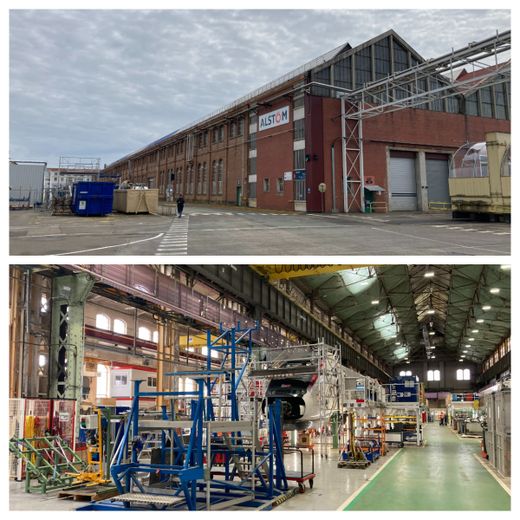
The immense workshop, several hundred meters long, actually lines up three halls side by side. In one, duplex trains are being completely renovated. FREE NOON – Ollivier Le Ny
A hall several hundred meters long
TADAM ! ✨
Découvrez le design de la future livrée TGV INOUI 🌱🚆
La 5ème génération de TGV mais aussi la concrétisation d'un projet industriel et d'innovation historique entre @SNCFVoyageurs et le concepteur-réalisateur français @AlstomFrance ✨ pic.twitter.com/bW7CHky0wN
— TGV INOUI (@TGVINOUI) April 29, 2024
A few minutes earlier, 700 m away this Monday morning, the French manufacturer and SNCF, its client, opened the door of hangar 235 on the final version of the TGV M, slowly exit from the low building where the TGV trains are parked, awaiting delivery. But here, in the Belfort factory, built between the end of the 19th and the beginning of the 20th centuries, employees and workers do not call it TGV M, any more than Avelia Horizon, its name in the Alstom range. This is the "TGV twenty twenty, for 2020". And they did not wait for the end of the certification tests to build it in mass production, the SNCF alone is waiting for 115 copies.
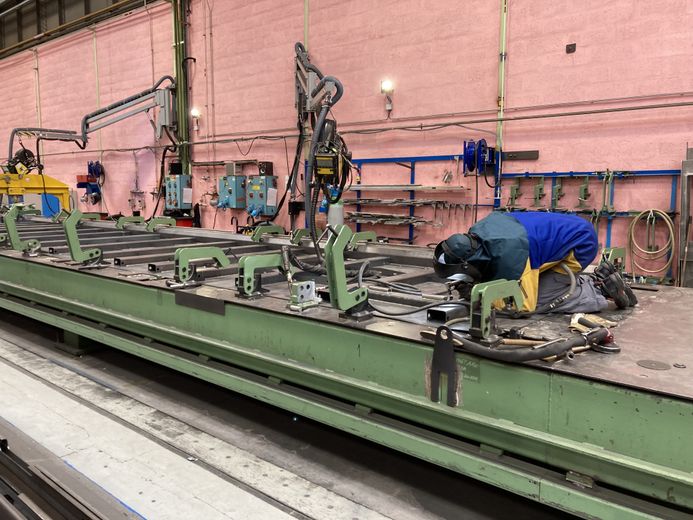
The preparation of the side walls and the assembly of the frame profiles mark the start of construction. FREE NOON – Ollivier Le Ny
80 days end to end, two units per month
Towards Belfort, everything converges from the eight industrial sites which supply the elements of the new train. Cars made in La Rochelle. The engines, bogies, traction chain and even the electrical systems, electronics, steel, etc., which Alstom workers and technicians will carry out power units, before final assembly and testing of the complete trainsets.
Here, we build machines with a power of 8,000,000 kW (more than 11,000 HP), capable of towing ten cars at 350 ;nbsp;km/h, at the rate of one unit every two weeks. From the first sheet to leaving the factory, the "transit time is 80 working days", indicates Jean-Baptiste Eymeoud , the director of Alstom France, that has to be the case.
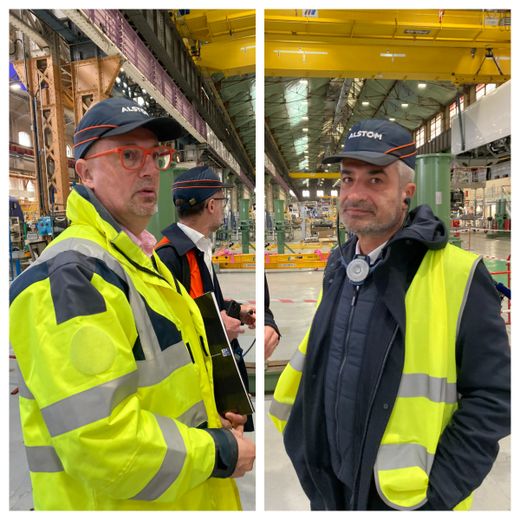
David Journet (L.), the director of the factory, and Jean-Baptiste Eymeoud, boss of Alstom France. FREE NOON – Ollivier Le Ny
40,000 pieces to assemble on the chain
Each one, with a final weight of 68 tonnes, is an assembly of 40,000 parts, some 4,000 different references. Starting from the steel profiles of the boilermaking, on the first station where the chassis is born, to arrive at the dashboard controls, installed at the last station which precedes the exit of the three parallel halls of the production line. assembly. Cathedrals so large that the TGV M are not alone there, moreover: here a freight locomotive with open entrails placed on jack stands; there, two dismantled duplex TGV trains, which, renovated, "will leave for thirty years", smiles David Journet. An operation which is part of "our programmed deobsolescence program for 104 trains", indicates Alain Krakovitch, director of TGV-Intercités at SNCF.
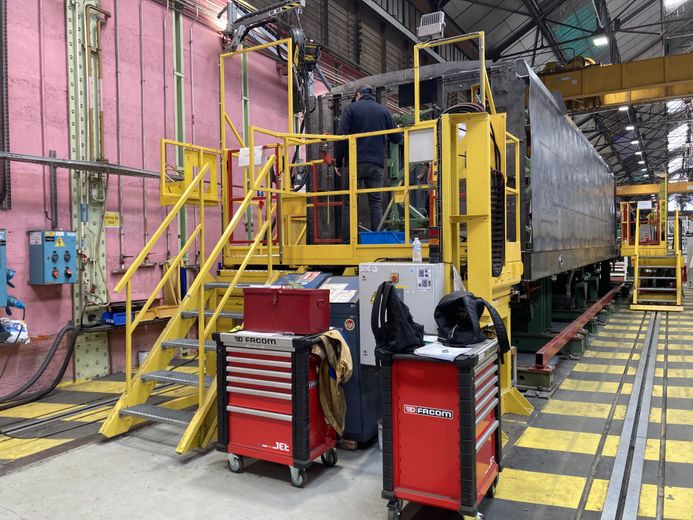
The body of the machine took shape, with the grafting of the side walls and the rear bulkhead. FREE NOON – Ollivier Le Ny
Sheets welded to the tenth of a millimeter
Four months, therefore, one engine behind the other, moved by the giant bridges, it's a caterpillar that moves forward. First the cauldron: the sheet metal walls are attached to the chassis, then the "rear partition and the cabin, described Martial Marhem, one of the boilermaking executives. Controls are carried out to the tenth of a millimeter, with laser trackers ", precision to be compared to the several tens of meters of length of a motor car.
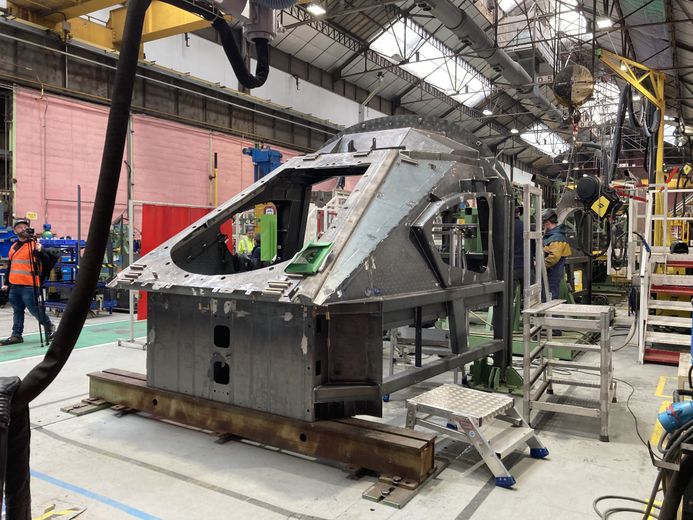
The driving cabin, raw, without its bodywork, waiting to be welded onto the cauldron. FREE NOON – Ollivier Le Ny
Boilermaking, painting, assembly, testing
The "construction site" then weighs 10 tonnes, it has already required 1,300,000 hours, 4,700 welds (2,000 km). We add 1 500 h for the paint, which will be spread over fourteen days, taking into account the drying times. And the engine can go to assembly, on six successive stations, the electrical wiring of which will be a piece of bravery. From the pantograph to the bogies, via transformers, motors, subsystems, etc. the electricians will have 12,000 meters of cables to pull… and this 230 times for the SNCF order alone, at the rate of two power cars per train.

Giant bridges move the power cars from one station to another. It weighs 50 tonnes at this stage. FREE NOON – Ollivier Le Ny
In 2025, the first five trainsets will be delivered to the French railway company. Then nine in 2026, twelve in 2027 and the following years. A contract worth 3.5 billion euros, but SNCF has already announced that it will need more.
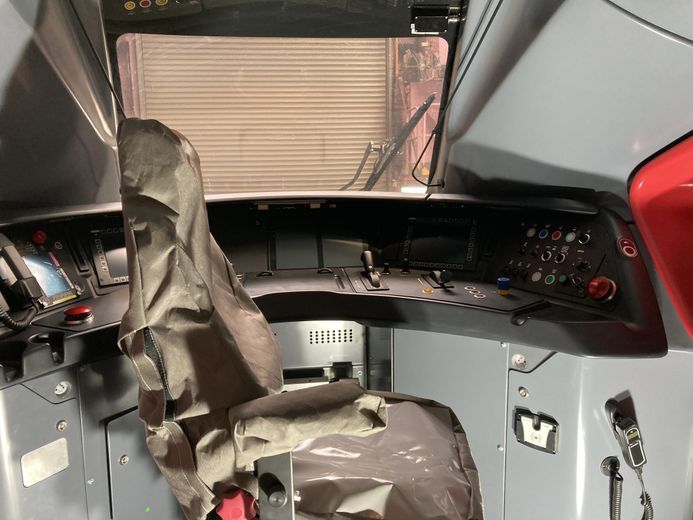
The TGV M driving cabin: the power car is finished, ready to leave the workshop. FREE NOON – Ollivier Le Ny
I subscribe to read more




